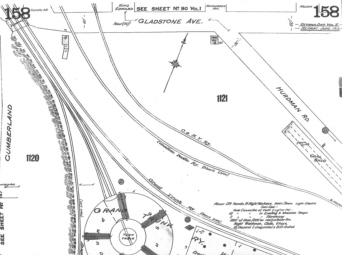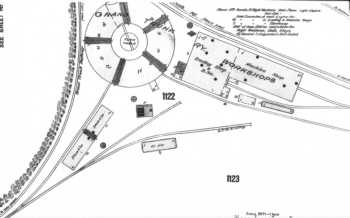

| Project Information |
| History |
| Mainstreeter |
| Churches |
| Scholasticate |
| Schools |
| Railways |
| Notables |
| After 1907 |
| 1901 Snapshot |
| Air Photo Study |
| Image Library |
| Databases |
| Search |
|
The Railway History
of Ottawa East
by Bruce Ballantyne |
|
| It is hard to image the link between the early days of Ottawa East and the railways. Cars speed past the community along the Queensway that covers the right-of-way where a once-busy railway ran. In fact, much of the growth of Ottawa in the late 1800s can be partly attributed to the coming of the Canada Atlantic Railway in 1882 with lumber magnate J.R. Booth's move into railway construction and ownership. | |
| As the western terminus of Booth's railway was Ottawa when construction was completed, facilities had to be built to service and maintain the locomotives and cars. This meant the construction of a roundhouse and repair shops. And so it was that the Canada Atlantic Railway (CAR) constructed a five-stall roundhouse on the property where the apartment building stands at the corner of Argyle and Elgin Street. Further west, a car shop was built at about Metcalfe and Catherine Streets along with the CAR's railway station. This shop built and repaired railway cars used by the company. | |
| In the early days of the railways, the maintenance of cars and locomotives was labour-intensive. Consequently there was a large workforce and this workforce would live within walking distance. As well, the daily preparation and maintenance of steam locomotives took a lot of people, from boiler makers and pipe fitters, as the trades were called, to the engine crew and hostlers (the men who moved the locomotives in and out of the roundhouse and spotted them for loading coal and water). These workers would be a part of the local community, including Ottawa East. | |
|
Why did Booth select the Ottawa East area as the site for his railway
facilities? There are likely a number of reasons. First, the location
of the line was at the southern boundary of the city and yet close enough
to get business from the city. Secondly, the land was mainly open country
so would be cheap to purchase. As well, he could bring coal in on the
canal for the locomotives (there are photos showing piles of coal and
loaded barges along the canal) and there was the prospect of business
with the transfer of freight from barge to railcar for final delivery. |
|
| Editor's Note: The four Fire Insurance Maps shown just below were reprinted in 1912 from 1902 information. | |
 |
 |
 |
 |